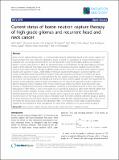Current status of boron neutron capture therapy of high grade gliomas and recurrent head and neck cancer
Author(s)
Barth, Rolf F; Vicente, M Graca H; Harling, Otto K; Kiger, W S III; Riley, Kent J; Binns, Peter J; Wagner, Franz M; Suzuki, Minoru; Aihara, Teruhito; Kato, Itsuro; Kawabata, Shinji; ... Show more Show less
Download1748-717X-7-146.pdf (2.747Mb)
PUBLISHER_CC
Publisher with Creative Commons License
Creative Commons Attribution
Terms of use
Metadata
Show full item recordAbstract
Boron neutron capture therapy (BNCT) is a biochemically targeted radiotherapy based on the nuclear capture and fission reactions that occur when non-radioactive boron-10, which is a constituent of natural elemental boron, is irradiated with low energy thermal neutrons to yield high linear energy transfer alpha particles and recoiling lithium-7 nuclei. Clinical interest in BNCT has focused primarily on the treatment of high grade gliomas, recurrent cancers of the head and neck region and either primary or metastatic melanoma. Neutron sources for BNCT currently have been limited to specially modified nuclear reactors, which are or until the recent Japanese natural disaster, were available in Japan, United States, Finland and several other European countries, Argentina and Taiwan. Accelerators producing epithermal neutron beams also could be used for BNCT and these are being developed in several countries. It is anticipated that the first Japanese accelerator will be available for therapeutic use in 2013. The major hurdle for the design and synthesis of boron delivery agents has been the requirement for selective tumor targeting to achieve boron concentrations in the range of 20 μg/g. This would be sufficient to deliver therapeutic doses of radiation with minimal normal tissue toxicity. Two boron drugs have been used clinically, a dihydroxyboryl derivative of phenylalanine, referred to as boronophenylalanine or “BPA”, and sodium borocaptate or “BSH” (Na2B12H11SH). In this report we will provide an overview of other boron delivery agents that currently are under evaluation, neutron sources in use or under development for BNCT, clinical dosimetry, treatment planning, and finally a summary of previous and on-going clinical studies for high grade gliomas and recurrent tumors of the head and neck region. Promising results have been obtained with both groups of patients but these outcomes must be more rigorously evaluated in larger, possibly randomized clinical trials. Finally, we will summarize the critical issues that must be addressed if BNCT is to become a more widely established clinical modality for the treatment of those malignancies for which there currently are no good treatment options.
Date issued
2012-08Department
Massachusetts Institute of Technology. Department of Nuclear Science and EngineeringJournal
Radiation Oncology
Publisher
Springer/BioMed Central Ltd
Citation
Barth, Rolf F et al. “Current Status of Boron Neutron Capture Therapy of High Grade Gliomas and Recurrent Head and Neck Cancer.” Radiation Oncology 7.1 (2012): 146. Web.
Version: Final published version
ISSN
1748-717X